A Miniaturized Transmitting LPDA Design for 2 MHz–30 MHz Uses
Abstract
:1. Introduction
2. Miniaturization Design and Optimization
2.1. Electrical Miniaturization and Antenna Design
- (1)
- Given D0 (dB), determine σ and τ from figure of computed contours of constant directivity versus σ and τ for log-periodic dipole arrays in [24]. Here the given gain D0 was set as 5 dB and σ = 0.05, τ = 0.84;
- (2)
- Determine the active region bandwidth Bar and designed bandwidth Bs by formula (2). The desired bandwidth was 4–30 MHz;
- (3)
- Find the total length of the structure L and the number of elements N in use of (3);
- (4)
- Determine the average characteristic impedance of the elements Za and the characteristic impedance of the feeder line Z0;
- (5)
- Optimize σ and τ with the assistant of full-wave simulation software FEKO.
2.2. Structural Miniaturization
3. Simulation and Verification
3.1. VSWR Results
3.2. Simulated Pattern
3.3. Simulated Gain
3.4. Verification
4. Conclusions
Author Contributions
Funding
Institutional Review Board Statement
Informed Consent Statement
Data Availability Statement
Conflicts of Interest
References
- Kang, E.; Lim, T.H.; Youn, S.; Lee, D.H.; Kim, K.B.; Choo, H. Design of a Miniaturized Printed Multi-Turn Loop Antenna for Shielding Effectiveness Measurement. IEEE Access 2020, 8, 54872–54878. [Google Scholar] [CrossRef]
- Zhang, T.; Su, H.; Tang, X.; Zhang, H.; Jing, Y.; Liu, B. Low-Loss Composite NiCuZnCo–BaTiO3 With Matched Permeability, Permittivity in High Frequency Range. IEEE Trans. Magn. 2014, 50, 2504104. [Google Scholar] [CrossRef]
- Shin, G.; Kong, M.; Lee, S.; Kim, S.; Yoon, I. Gain Characteristic Maintained, Miniaturized LPDA Antenna Using Partially Applied Folded Planar Helix Dipoles. IEEE Access 2018, 6, 25874–25880. [Google Scholar] [CrossRef]
- Zheng, Z.; Wu, X.A. Miniaturized UHF Vivaldi Antenna With Tailored Radiation Performance Based on Magneto-Dielectric Ferrite Materials. IEEE Trans. Magn. 2020, 56, 6702505. [Google Scholar] [CrossRef]
- Pu, J.; Zhang, B. A Miniaturized Log-Periodic Dipole Antenna Using Dual-Band Top-Loaded Dipoles as Radiating Elements. In Proceedings of the 2020 IEEE MTT-S International Microwave Workshop Series on Advanced Materials, Processes for RF, THz Applications (IMWS-AMP), Suzhou, China, 29–31 July 2020; pp. 1–3. [Google Scholar] [CrossRef]
- Luan, S.; Liu, X.; Qiu, J. A novel miniaturized ultra wideband log-periodic antenna. In Proceedings of the 2010 5th International Confernce on Ultrawideband, Ultrashort Impulse Signals, Sevastopol, Ukraine, 6–10 September 2010; pp. 246–248. [Google Scholar] [CrossRef]
- Lee, J.; Ham, H.; Ryu, H.; Woo, J.; Park, B.; Lee, K. Miniaturization of log-periodic dipole array antenna using triangular meander structure. In Proceedings of the 2012 IEEE International Conference on Wireless Information Technology, Systems (ICWITS), Maui, HI, USA, 11–16 November 2012; pp. 1–4. [Google Scholar] [CrossRef]
- Notaros, M.; Ignatenko, M.; Filipovic, D.S. Miniaturization of a high-frequency dual linearly polarized dipole for vehicular communications. In Proceedings of the 2016 IEEE International Symposium on Antennas, Propagation (APSURSI), Fajardo, PR, USA, 26 June–1 July 2016; pp. 1751–1752. [Google Scholar] [CrossRef]
- Qiu, J.; Lv, Y.; Zhang, Y.; Tenigeer. Novel miniaturized broadband HF antenna. In Proceedings of the 2012 International Conference on Microwave, Millimeter Wave Technology (ICMMT), Shenzhen, China, 5–8 May 2012; pp. 1–3. [Google Scholar] [CrossRef]
- Shnitkin, H. Miniaturization techniques for HF log-periodic dipole arrays. In Proceedings of the 1980 Antennas, Propagation Society International Symposium, Quebec, Canada, 2–6 June 1980; pp. 316–319. [Google Scholar] [CrossRef]
- Xia, Y.; Li, Y.; Jiang, J.; Xue, W. An Inverted E-Like Antenna Loaded with Lumped Elements for 5MHz-343MHz Applications. In Proceedings of the 2019 International Workshop on Electromagnetics: Applications, Student Innovation Competition (iWEM), Qingdao, China, 18–20 September 2019; pp. 1–2. [Google Scholar] [CrossRef]
- Baker, J.M.; Iskander, M.F. A New Design Approach for Electrically Small High-Frequency Antennas. IEEE Antennas Wirel. Propag. Lett. 2015, 14, 402–405. [Google Scholar] [CrossRef]
- Gulati, G.; Abdelrahman, A.H.; Tang, Q.; Liang, M.; Bose, T.; Xin, H. Passive, active matching of electrically-small helical antenna for HF-band communications. In Proceedings of the 2017 IEEE International Symposium on Antennas, Propagation & USNC/URSI National Radio Science Meeting, San Diego, CA, USA, 9–14 July 2017; pp. 733–734. [Google Scholar] [CrossRef]
- Kawabata, K.; Arai, H. Efficient Antenna Design for Platform-Mounted HF Antennas Using Characteristic Mode Theory. In Proceedings of the 2018 IEEE International Workshop on Electromagnetics:Applications, Student Innovation Competition (iWEM), Nagoya, Japan, 29–31 August; p. 1. [CrossRef]
- Shih, T.; Behdad, N. Bandwidth enhancement of HF antennas mounted on military platforms using a Characteristic-Modes-Based Design Approach. In Proceedings of the 2015 International Symposium on Antennas, Propagation (ISAP), Hobart, TAS, Australia, 9–12 November 2015; pp. 1–3. [Google Scholar]
- Lan, T.T.; Kawabata, K.; Arai, H. Utilization of Inverted-F Antenna Elements to Design a Platform-Mounted HF Antenna. In Proceedings of the 2019 International Conference on Advanced Technologies for Communications (ATC), Hanoi, Vietnam, 17–19 October 2019; pp. 15–18. [Google Scholar] [CrossRef]
- Sanghai, S.A.; Ignatenko, M.; Filipovic, D.S. Low-Profile Two-Arm Inverted-L Antenna Design for Vehicular HF Communications. IEEE Trans. Antennas Propag. 2017, 65, 5710–5719. [Google Scholar] [CrossRef]
- Zhang, X.; Gao, H.; Zhang, Q. An optimum design of low-profile ultra-wideband HF skeletal wire duoconical monopole antenna with parasitic grounded poles. In Proceedings of the 2016 IEEE-APS Topical Conference on Antennas, Propagation in Wireless Communications (APWC), Cairns, QLD, Australia, 19–23 September 2016; pp. 264–267. [Google Scholar] [CrossRef]
- International Telecommunication Union Recommendation ITU-R P.372-14 (08/2019), Radio Noise, P Series Radiowave Propagation. pp. 3–6. Available online: http://www.itu.int/publ/R-REC/en (accessed on 6 September 2021).
- Zhang, X.L.; Gao, H.T. An optimum design of miniaturized high frequency inverted-V log-periodic dipole antenna. In Proceedings of the 2011 IEEE CIE International Conference on Radar, Chengdu, China, 24–27 October 2011; pp. 1185–1188. [Google Scholar] [CrossRef]
- TCI Antenna Selection Guide; Technology for Communication International, Ltd.: Washington, DC, USA, 2010.
- Rafaei-Booket, M.; Bozorgi, M. Implementation of a Dual-band, Miniaturized Log-Periodic Dipole Antenna loaded by ENG Cells. In Proceedings of the 2020 28th Iranian Conference on Electrical Engineering (ICEE), Tabriz, Iran, 4–6 August 2020; pp. 1–5. [Google Scholar] [CrossRef]
- Wang, Z.F.; Fu, J.H. A design of miniaturization LPDA antenna with ultra wideband. In Proceedings of the 6th International Symposium on Microwave, Antenna, Propagation, and EMC Technologies (MAPE), Shanghai, China, 28–30 October 2015; pp. 819–821. [Google Scholar] [CrossRef]
- Balanis, C.A. Antenna Theory Analysis, Design; John Wiley & Sons, Inc.: Hoboken, NJ, USA, 2016; pp. 624–626. [Google Scholar]
- Lin, C.; Nie, Z. Antenna and Feeding Line; People’s Posts and Telecommunications Press: Beijing, China, 1985; pp. 231–239. [Google Scholar]
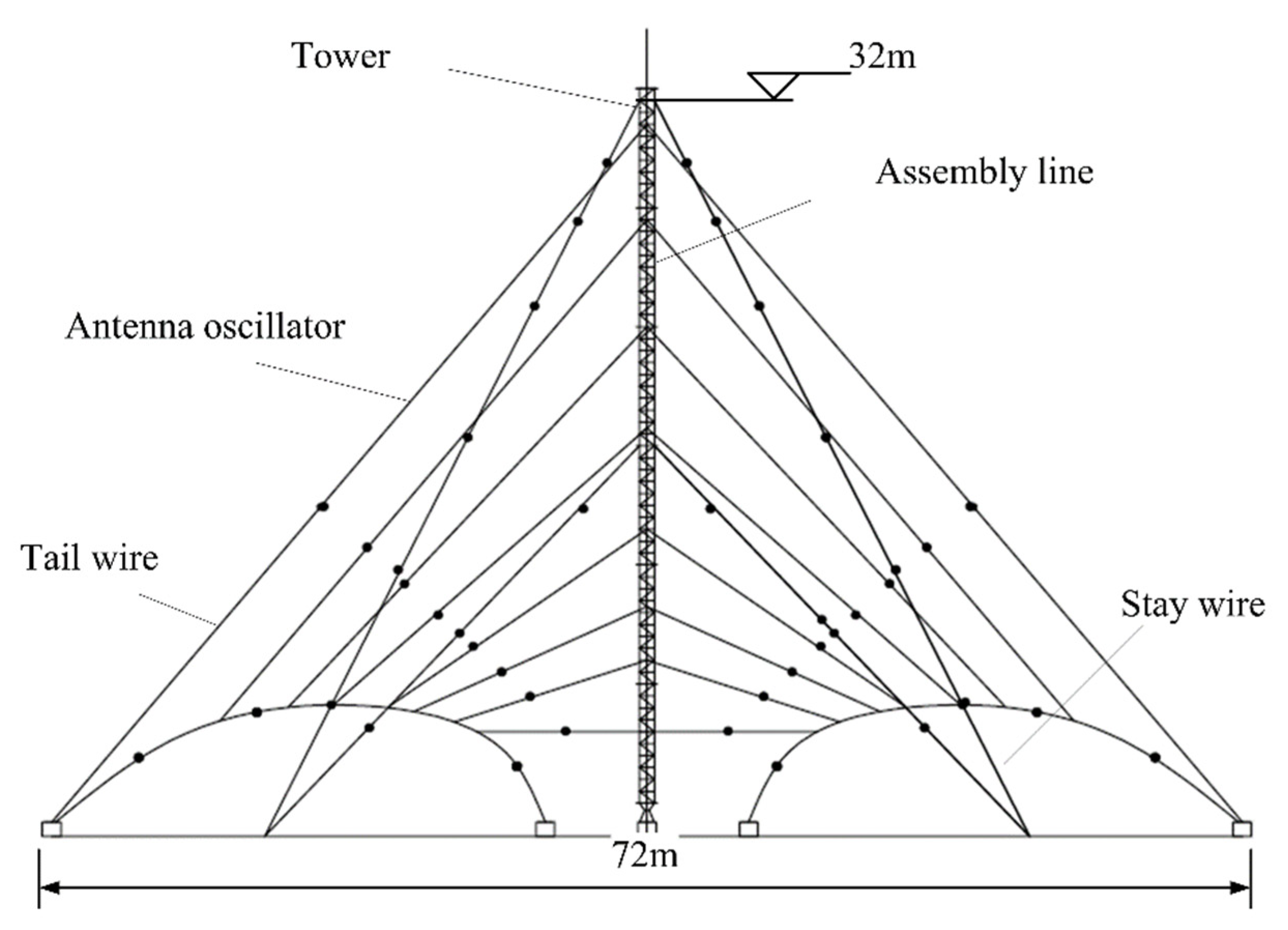
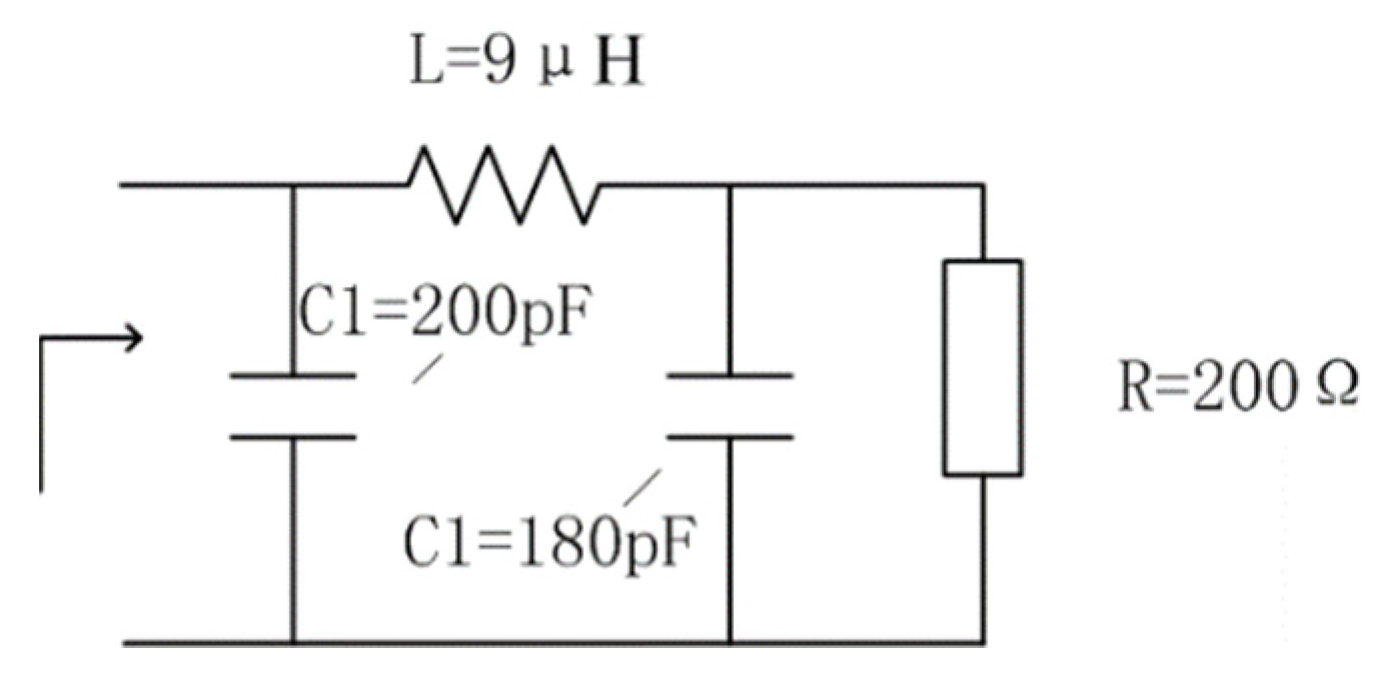

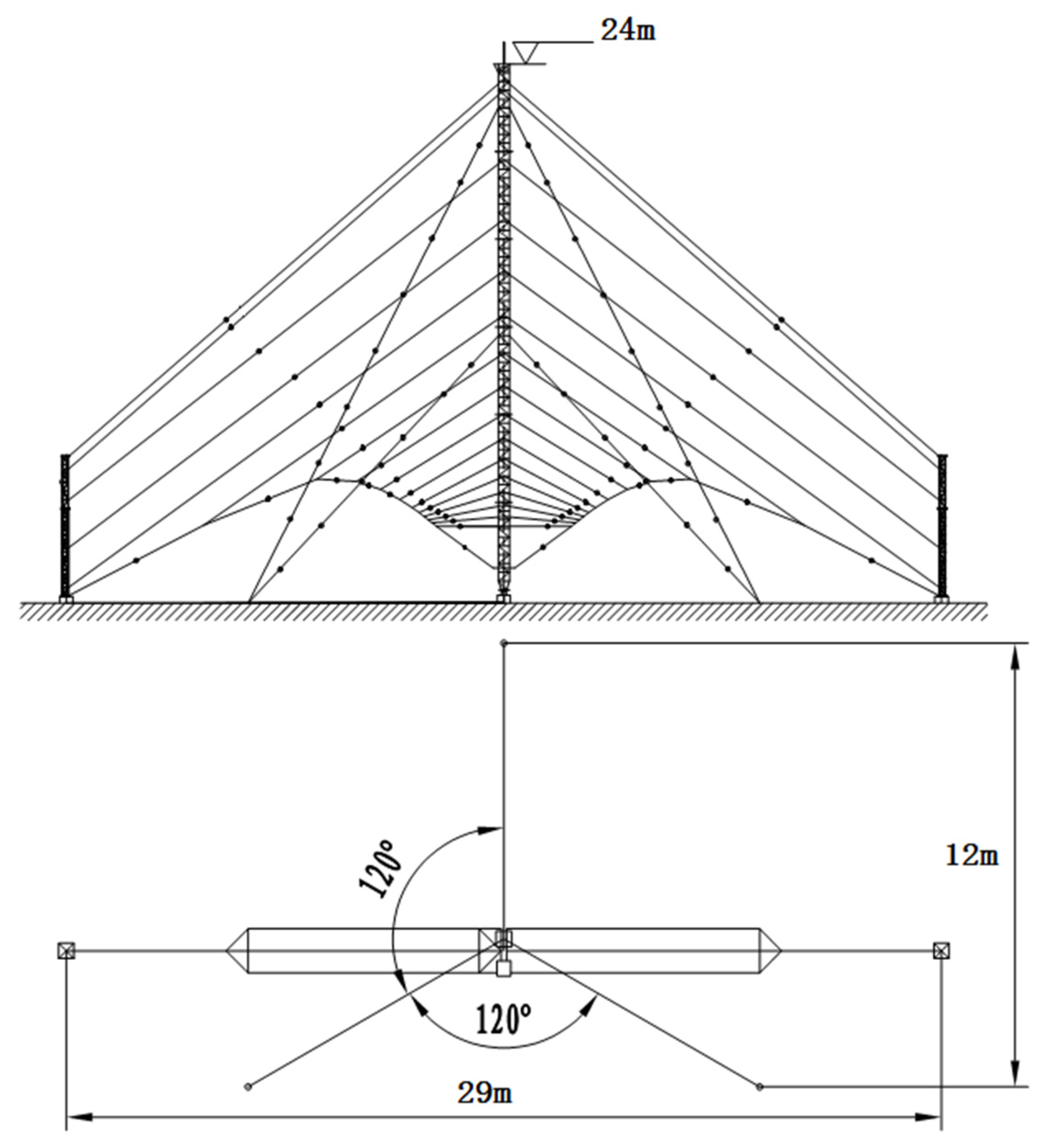

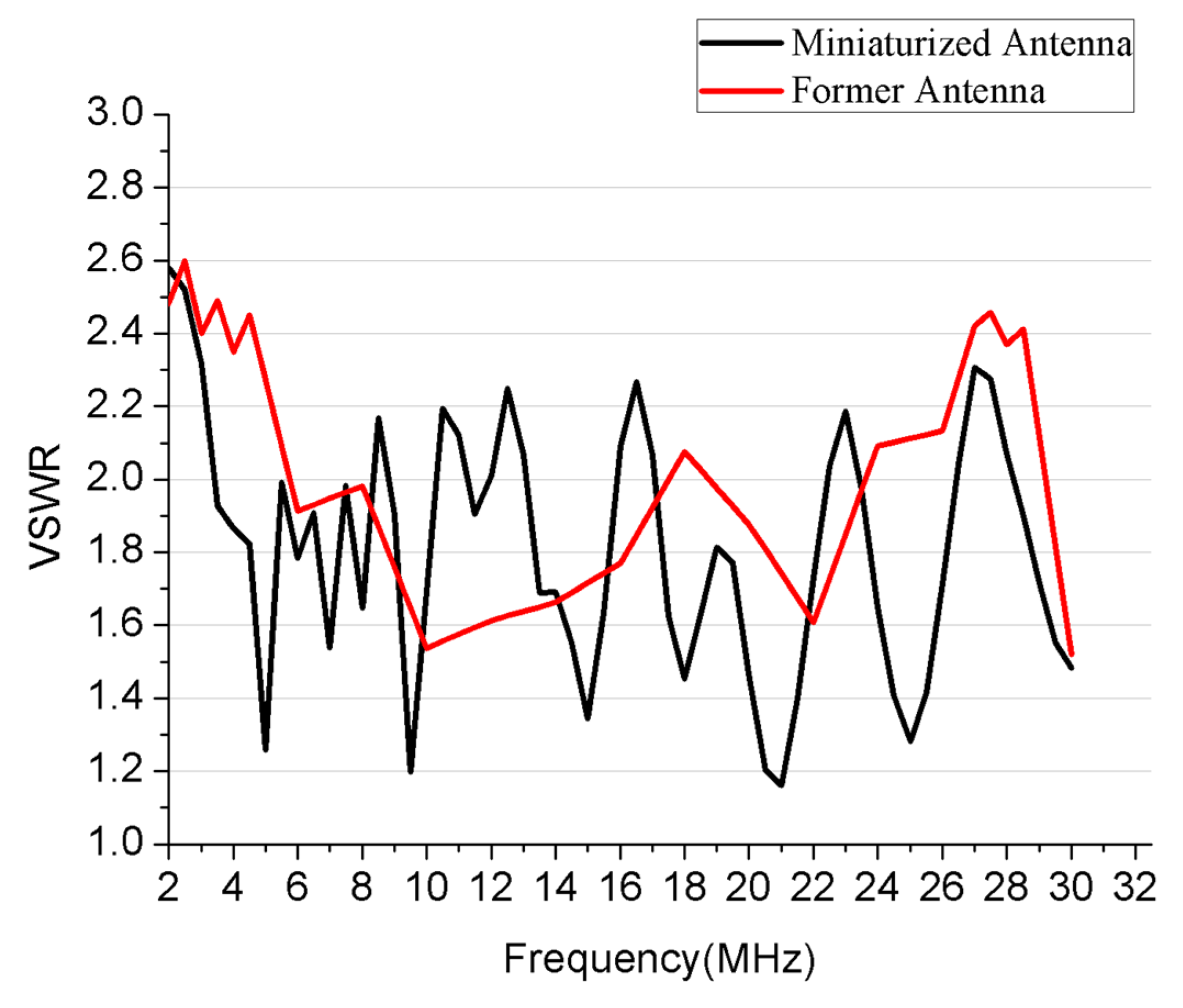
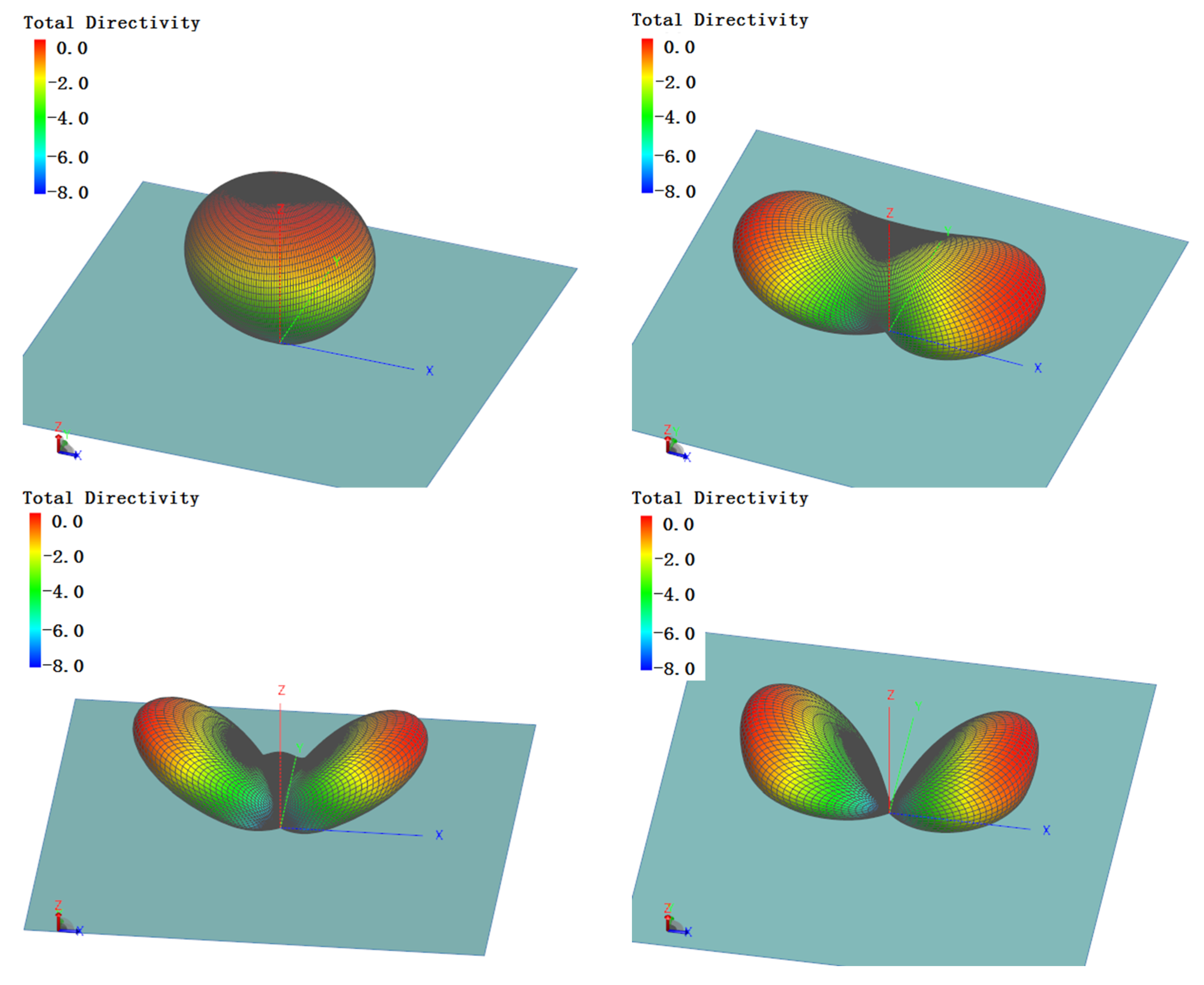
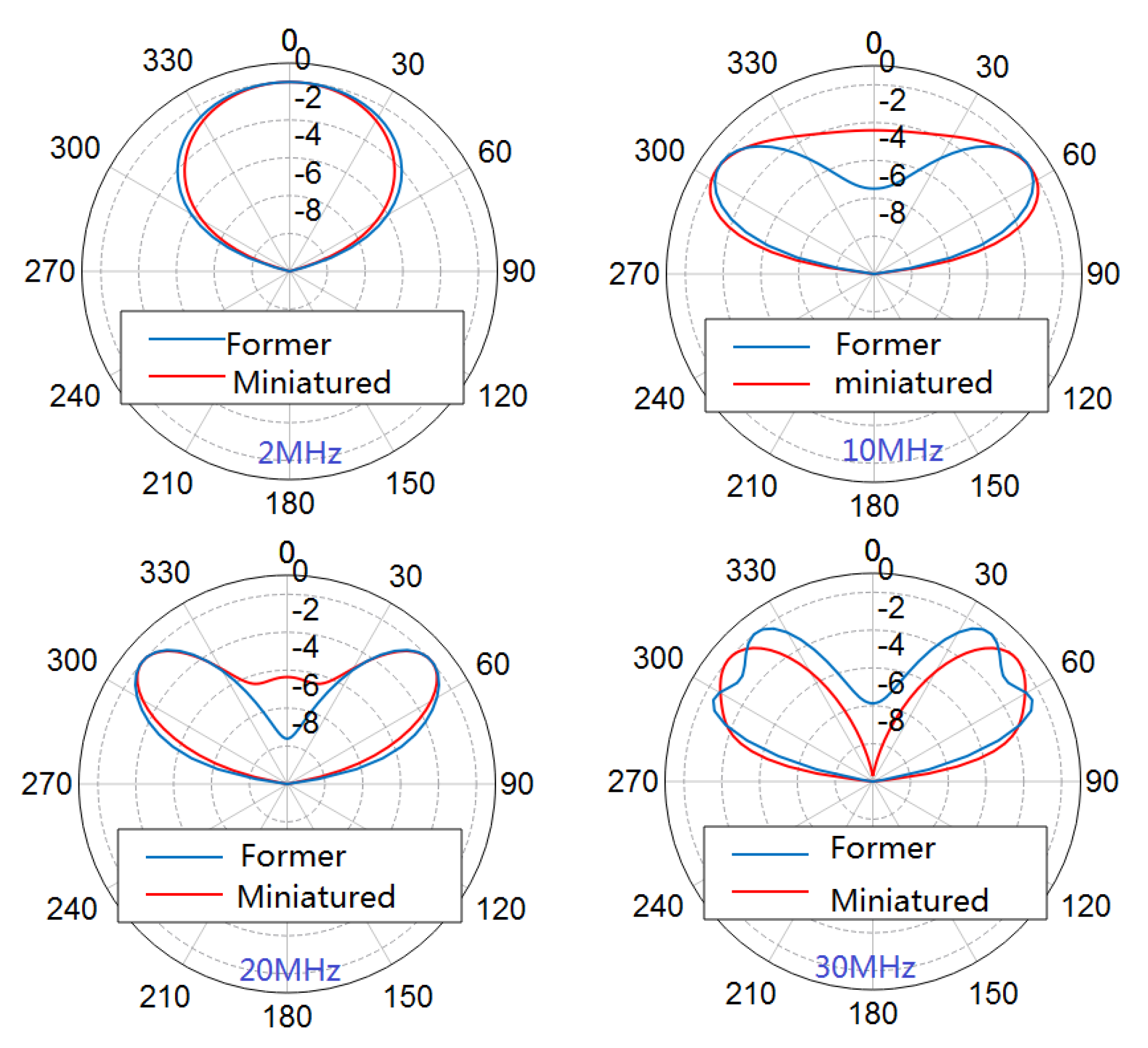
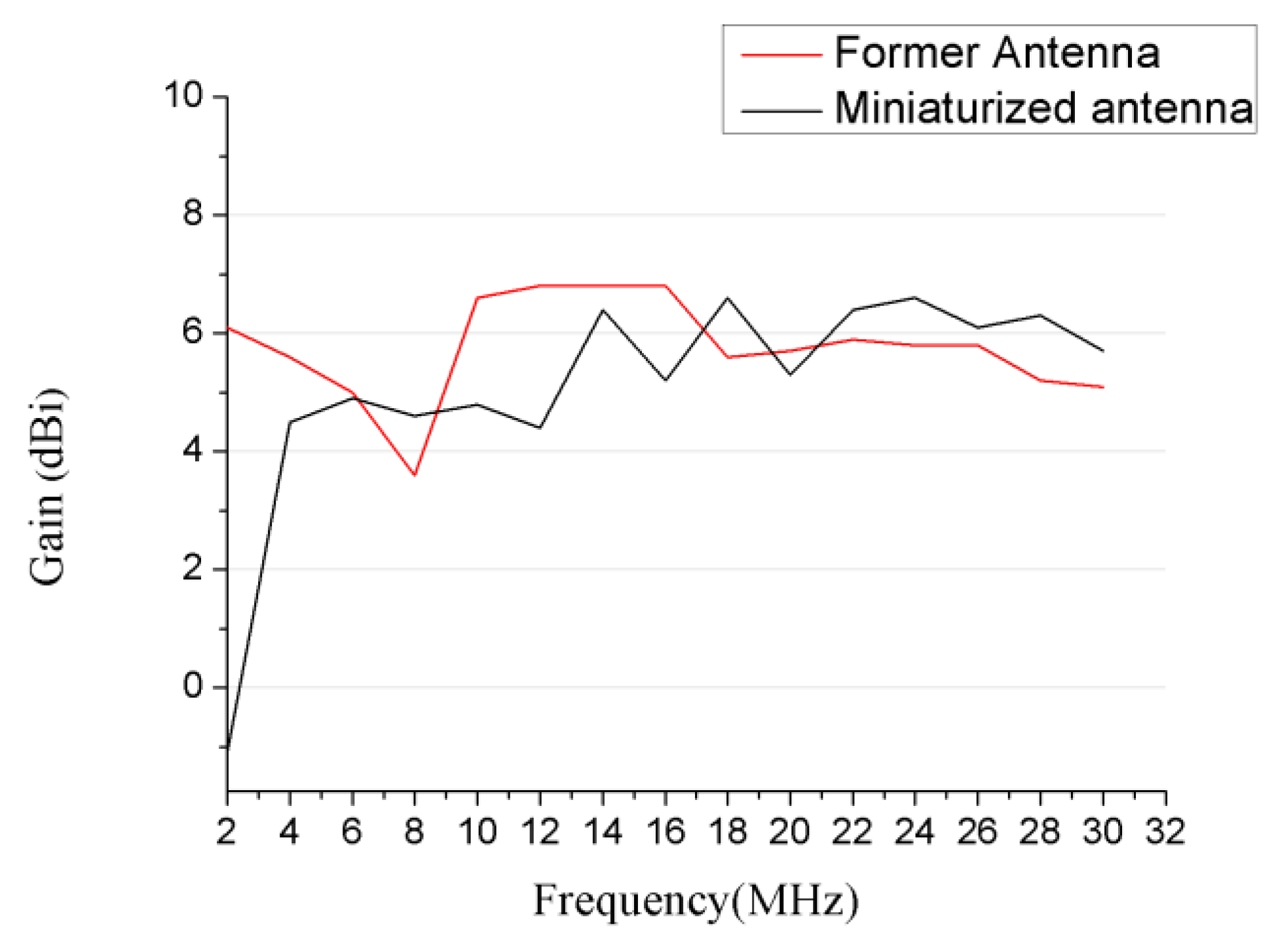
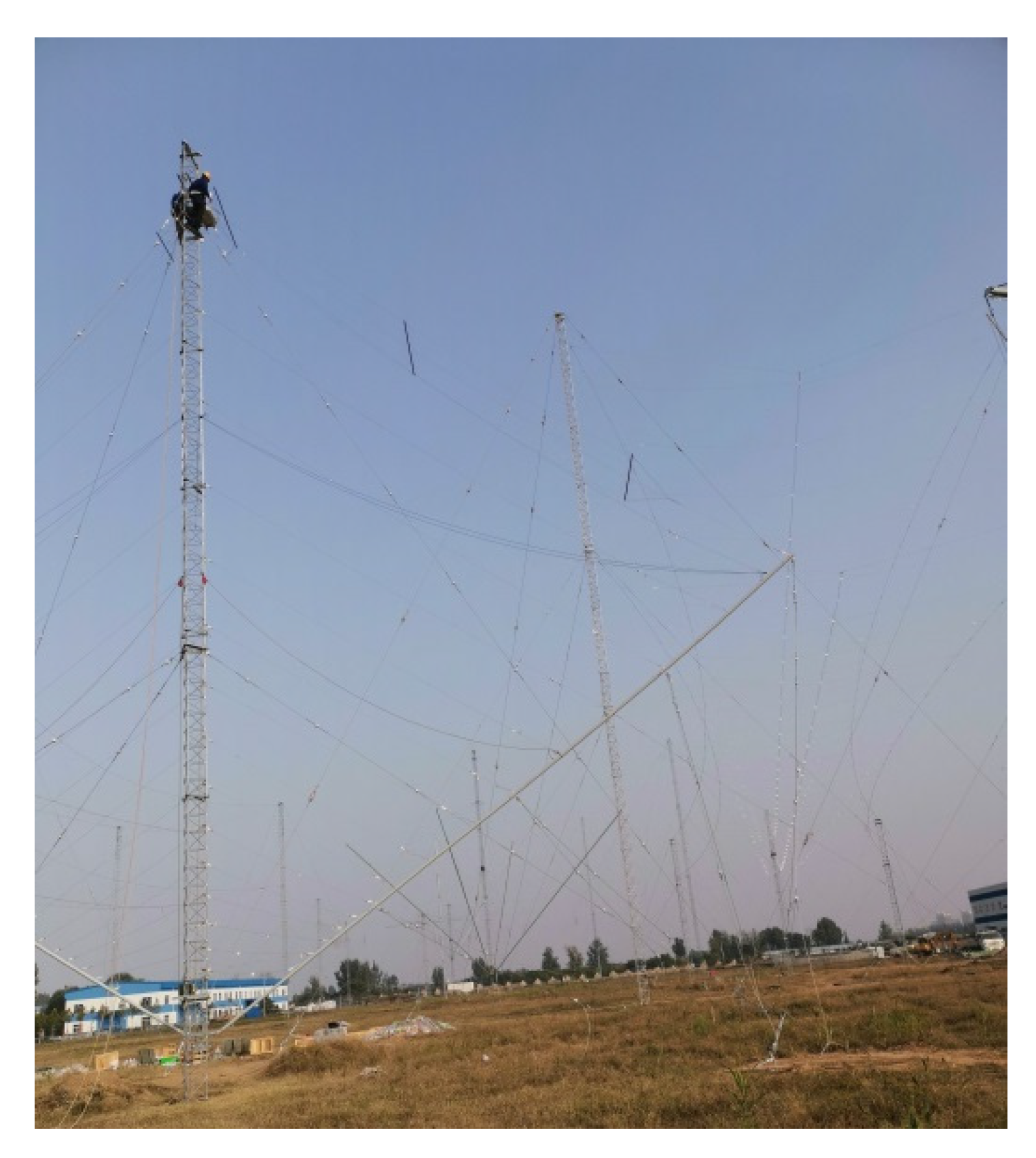

| Item | Our Proposal | TCI 530 | Duoconical Monopole | Invert-V LPDA |
|---|---|---|---|---|
| Dimension | 29 m × 24 m | 72 m × 32 m | 20 m × 6 m | 30 m × 19.8 m |
| Impedance Bandwidth | 2–30 MHz | 2–30 MHz | 7.5–25 MHz | 6–30 MHz |
| Gain | 5–7 dBi (over 4 MHz) | 4–7 dBi | 0.2 dBi | 2–8 dBi |
| VSWR | ≤2.5 | ≤2.5 | ≤3.0 | ≤2.5 |
| Dipole Number | Σ | τ | Θ (°) |
|---|---|---|---|
| 1 | 0.050 | 0.86 | 93 |
| 2 | 0.051 | 0.86 | 102 |
| 3 | 0.053 | 0.86 | 104 |
| 4 | 0.054 | 0.86 | 110 |
| 5 | 0.055 | 0.86 | 112 |
| 6 | 0.057 | 0.87 | 116 |
| 7 | 0.058 | 0.87 | 118 |
| 8 | 0.059 | 0.87 | 123 |
| 9 | 0.060 | 0.87 | 130 |
| 10 | 0.060 | 0.87 | 135 |
| 11 | 0.060 | 0.88 | 140 |
| 12 | 0.060 | 0.88 | 145 |
| 13 | 0.061 | 0.88 | 155 |
| 14 | 0.061 | 0.88 | 163 |
| 15 | 0.062 | 0.88 | 175 |
| 16 | 0.062 | 0.88 | 180 |
| Item | Our Proposal | Former Antenna | |
|---|---|---|---|
| Dimension | 29 × 24 m | 72 × 32 m | |
| Impedance Bandwidth | 2–30 MHz | 2–30 MHz | |
| Gain | 5–7 dBi (over 4 MHz) | 4–7 dBi | |
| VSWR | ≤2.5 | ≤2.5 | |
| Maximum Radiation Angle | 2 MHz | 0° | 0° |
| 15 MHz | 60° | 57° | |
| 30 MHz | 50° | 48° | |
| 3 dB Lobe Width (Horizontal plane) | 2 MHz | 102° | 107° |
| 15 MHz | 86° | 80° | |
| 30 MHz | 83° | 79° | |
Publisher’s Note: MDPI stays neutral with regard to jurisdictional claims in published maps and institutional affiliations. |
© 2021 by the authors. Licensee MDPI, Basel, Switzerland. This article is an open access article distributed under the terms and conditions of the Creative Commons Attribution (CC BY) license (https://creativecommons.org/licenses/by/4.0/).
Share and Cite
Zhu, W.; Guo, L. A Miniaturized Transmitting LPDA Design for 2 MHz–30 MHz Uses. Sensors 2021, 21, 6034. https://doi.org/10.3390/s21186034
Zhu W, Guo L. A Miniaturized Transmitting LPDA Design for 2 MHz–30 MHz Uses. Sensors. 2021; 21(18):6034. https://doi.org/10.3390/s21186034
Chicago/Turabian StyleZhu, Wenjun, and Lixin Guo. 2021. "A Miniaturized Transmitting LPDA Design for 2 MHz–30 MHz Uses" Sensors 21, no. 18: 6034. https://doi.org/10.3390/s21186034
APA StyleZhu, W., & Guo, L. (2021). A Miniaturized Transmitting LPDA Design for 2 MHz–30 MHz Uses. Sensors, 21(18), 6034. https://doi.org/10.3390/s21186034






